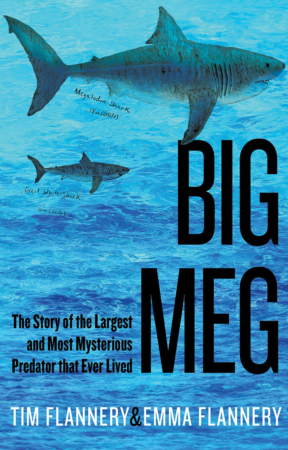Look over here and say “Cheeeeeeese!”
Let’s see those chompers, those pearly-whites. How ’bout a big grin, ear to ear. You’ve got a full set of gorgeous teeth, why not show them off? Smile – especially if, as in the new book “Big Meg” by Tim Flannery & Emma Flannery, one tooth is as big as a toddler’s hand.
Growing up in Victoria, Australia, Tim Flannery enjoyed fossil hunting on both land and just off the coast. It was more than a hobby for him – it was an obsession, a way to make money and to learn about that branch of science. He still recalls a large fossil he found in 1973, the tooth of Otodus megalodon, a shark that had gone extinct millions of years ago.
At a possible 101,600 kilograms (around 112 tons), a theoretical 20 meters long (nearly 22 yards or almost 66 feet), and a bite force roughly twice that of a Tyrannosaurus rex, the Otodus megalodon was no shrinking violet. Informally known as “Meg,” was the largest predator the Earth had ever seen. Ever.
Flannery wasn’t the only one who was fascinated by the gigantic predator.
It’s thought that Ancient societies used megalodon teeth in rituals and as tools. Fossil hunters avidly look for them in known spots. Museums love having Meg’s teeth and dealers sell them to private collectors online. Flannery says that there are likely millions of teeth not yet discovered, mostly because each Meg had “tooth stacks” and hundreds of razor-sharp, killing-machine teeth in its mouth at any one time.
And yet, despite that humans’ evolutionary lineage and Meg’s overlapped a bit, our knowledge about the megalodon is really quite limited. Little can be learned from its bones, since Meg had a cartilaginous skeleton and cartilage doesn’t fossilize well. We can extrapolate information from any of the fifteen species of its cousins that live. And maybe, says Flannery, we’ll know first-hand: some people believe that the megalodon still exists…
If you’ve read this far, it’s pretty safe to say that deep, deep inside you lies the heart of a five-year-old who thinks sharks are the coolest creatures alive. They’re the coolest creatures dead, too, as you’ll see inside “Big Meg.”
It’s unfortunate, actually, that most kids are too young to read a book like this. Authors Tim Flannery and Emma Flannery, a father-daughter team, write in great detail about creatures that can hold a lot of fascination for all ages: longer than an average ranch-style home, Meg didn’t live in a vacuum, so the authors include facts about other marine animals, both ancient and current, in their narrative, as a touchstone. This may irritate some readers – it means a lot of subject-bouncing and an overabundance of seemingly-irrelevant, seemingly-superfluous info – but stay with it. The mind-boggling is ultimately worth it.
This is the kind of book that makes you want to drop “Did you know?” at the dinner table tonight. It’s a shark-lover’s dream read. Share it with a kid, if you can; “Big Meg” will make you both smile.
“Big Meg: The Story of the Largest and Most Mysterious Predator that Ever Lived” by Tim Flannery and Emma Flannery
c.2024, Atlantic Monthly Press
$27.00
208 pages




